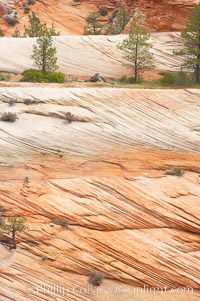
Navajo sandstone forms the cliffs and walls of Zion National Park. The sandstone reaches a thickness of 2300 feet and consists of ancient cemented desert sand dunes. Horizontal lines, commonly called crossbedding, represent layers of wind-blown sand that built up into sand dunes. These dunes were then buried, and the sand grains glued together by calcite and iron oxide to form sandstone.
Location: Zion National Park, Utah
Image ID: 12520
Location: Zion National Park, Utah
Image ID: 12520
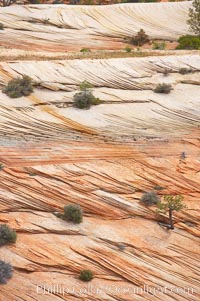
Navajo sandstone forms the cliffs and walls of Zion National Park. The sandstone reaches a thickness of 2300 feet and consists of ancient cemented desert sand dunes. Horizontal lines, commonly called crossbedding, represent layers of wind-blown sand that built up into sand dunes. These dunes were then buried, and the sand grains glued together by calcite and iron oxide to form sandstone.
Location: Zion National Park, Utah
Image ID: 12521
Location: Zion National Park, Utah
Image ID: 12521
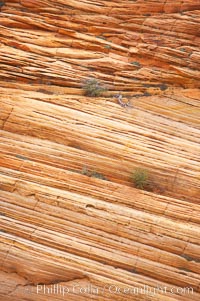
Navajo sandstone forms the cliffs and walls of Zion National Park. The sandstone reaches a thickness of 2300 feet and consists of ancient cemented desert sand dunes. Horizontal lines, commonly called crossbedding, represent layers of wind-blown sand that built up into sand dunes. These dunes were then buried, and the sand grains glued together by calcite and iron oxide to form sandstone.
Location: Zion National Park, Utah
Image ID: 12522
Location: Zion National Park, Utah
Image ID: 12522
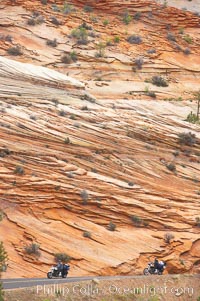
Navajo sandstone forms the cliffs and walls of Zion National Park. The sandstone reaches a thickness of 2300 feet and consists of ancient cemented desert sand dunes. Horizontal lines, commonly called crossbedding, represent layers of wind-blown sand that built up into sand dunes. These dunes were then buried, and the sand grains glued together by calcite and iron oxide to form sandstone.
Location: Zion National Park, Utah
Image ID: 12523
Location: Zion National Park, Utah
Image ID: 12523
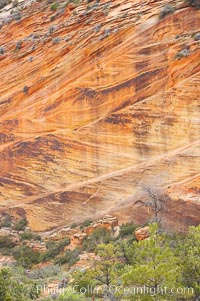
Navajo sandstone forms the cliffs and walls of Zion National Park. The sandstone reaches a thickness of 2300 feet and consists of ancient cemented desert sand dunes. Horizontal lines, commonly called crossbedding, represent layers of wind-blown sand that built up into sand dunes. These dunes were then buried, and the sand grains glued together by calcite and iron oxide to form sandstone.
Location: Zion National Park, Utah
Image ID: 12524
Location: Zion National Park, Utah
Image ID: 12524
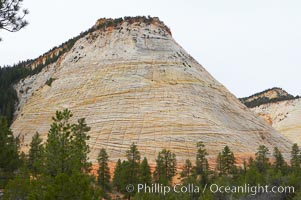
Checkerboard Mesa, a good example of crossbedding (horizontal lines) and vertical cracks caused by thermal expansion/contraction. Navajo sandstone forms the cliffs and walls of Zion National Park. The sandstone reaches a thickness of 2300 feet and consists of ancient cemented desert sand dunes. Horizontal lines, commonly called crossbedding, represent layers of wind-blown sand that built up into sand dunes. These dunes were then buried, and the sand grains glued together by calcite and iron oxide to form sandstone.
Location: Zion National Park, Utah
Image ID: 12526
Location: Zion National Park, Utah
Image ID: 12526
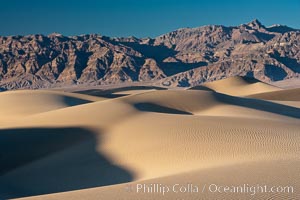
Sand Dunes, California. Near Stovepipe Wells lies a region of sand dunes, some of them hundreds of feet tall.
Location: Stovepipe Wells, Death Valley National Park, California
Image ID: 15587
Location: Stovepipe Wells, Death Valley National Park, California
Image ID: 15587

Sand Dunes, California. Near Stovepipe Wells lies a region of sand dunes, some of them hundreds of feet tall.
Location: Stovepipe Wells, Death Valley National Park, California
Image ID: 15588
Location: Stovepipe Wells, Death Valley National Park, California
Image ID: 15588
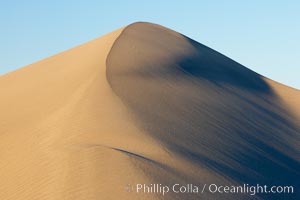
Sand Dunes, California. Near Stovepipe Wells lies a region of sand dunes, some of them hundreds of feet tall.
Location: Stovepipe Wells, Death Valley National Park, California
Image ID: 15589
Location: Stovepipe Wells, Death Valley National Park, California
Image ID: 15589
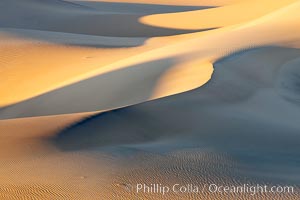
Sand Dunes, California. Near Stovepipe Wells lies a region of sand dunes, some of them hundreds of feet tall.
Location: Stovepipe Wells, Death Valley National Park, California
Image ID: 15590
Location: Stovepipe Wells, Death Valley National Park, California
Image ID: 15590
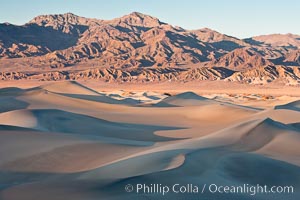
Sand Dunes, California. Near Stovepipe Wells lies a region of sand dunes, some of them hundreds of feet tall.
Location: Stovepipe Wells, Death Valley National Park, California
Image ID: 15591
Location: Stovepipe Wells, Death Valley National Park, California
Image ID: 15591
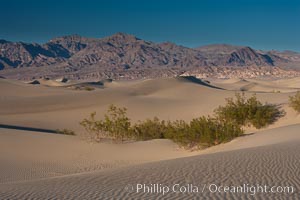
Sand Dunes, California. Near Stovepipe Wells lies a region of sand dunes, some of them hundreds of feet tall.
Location: Stovepipe Wells, Death Valley National Park, California
Image ID: 15603
Location: Stovepipe Wells, Death Valley National Park, California
Image ID: 15603
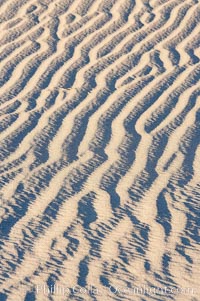
Ripples in sand dunes at sunset, California. Winds reshape the dunes each day. Early morning walks among the dunes can yield a look at sidewinder and kangaroo rats tracks the nocturnal desert animals leave behind.
Location: Stovepipe Wells, Death Valley National Park, California
Image ID: 15604
Location: Stovepipe Wells, Death Valley National Park, California
Image ID: 15604
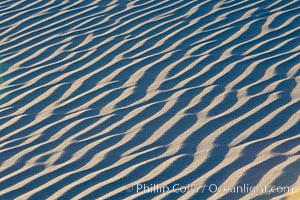
Ripples in sand dunes at sunset, California. Winds reshape the dunes each day. Early morning walks among the dunes can yield a look at sidewinder and kangaroo rats tracks the nocturnal desert animals leave behind.
Location: Stovepipe Wells, Death Valley National Park, California
Image ID: 15605
Location: Stovepipe Wells, Death Valley National Park, California
Image ID: 15605
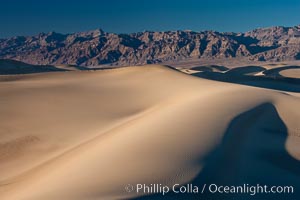
Sand Dunes, California. Near Stovepipe Wells lies a region of sand dunes, some of them hundreds of feet tall.
Location: Stovepipe Wells, Death Valley National Park, California
Image ID: 15606
Location: Stovepipe Wells, Death Valley National Park, California
Image ID: 15606
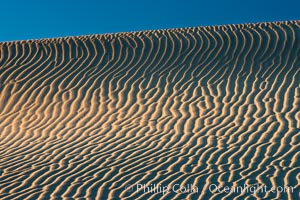
Ripples in sand dunes at sunset, California. Winds reshape the dunes each day. Early morning walks among the dunes can yield a look at sidewinder and kangaroo rats tracks the nocturnal desert animals leave behind.
Location: Stovepipe Wells, Death Valley National Park, California
Image ID: 15607
Location: Stovepipe Wells, Death Valley National Park, California
Image ID: 15607
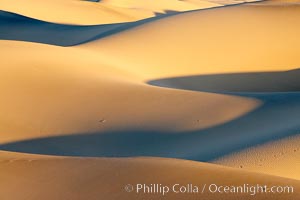
Sand Dunes, California. Near Stovepipe Wells lies a region of sand dunes, some of them hundreds of feet tall.
Location: Stovepipe Wells, Death Valley National Park, California
Image ID: 15608
Location: Stovepipe Wells, Death Valley National Park, California
Image ID: 15608
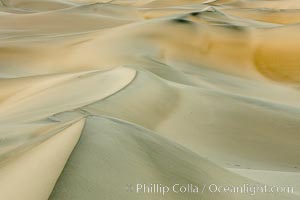
Sand Dunes, California. Near Stovepipe Wells lies a region of sand dunes, some of them hundreds of feet tall.
Location: Stovepipe Wells, Death Valley National Park, California
Image ID: 15609
Location: Stovepipe Wells, Death Valley National Park, California
Image ID: 15609
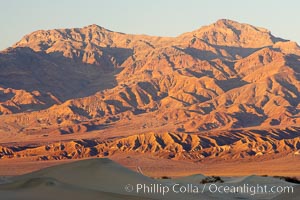
Grapevine Mountain Range, with sand dunes in the foreground. Sunset.
Location: Stovepipe Wells, Death Valley National Park, California
Image ID: 15610
Location: Stovepipe Wells, Death Valley National Park, California
Image ID: 15610
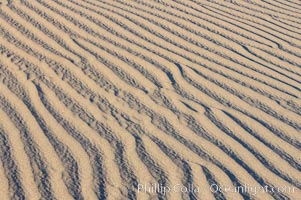
Ripples in sand dunes at sunset, California. Winds reshape the dunes each day. Early morning walks among the dunes can yield a look at sidewinder and kangaroo rats tracks the nocturnal desert animals leave behind.
Location: Stovepipe Wells, Death Valley National Park, California
Image ID: 15630
Location: Stovepipe Wells, Death Valley National Park, California
Image ID: 15630
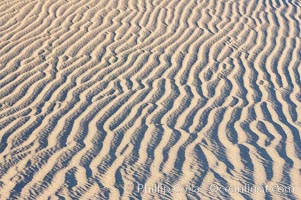
Ripples in sand dunes at sunset, California. Winds reshape the dunes each day. Early morning walks among the dunes can yield a look at sidewinder and kangaroo rats tracks the nocturnal desert animals leave behind.
Location: Stovepipe Wells, Death Valley National Park, California
Image ID: 15631
Location: Stovepipe Wells, Death Valley National Park, California
Image ID: 15631

Sand Dunes, California. Near Stovepipe Wells lies a region of sand dunes, some of them hundreds of feet tall.
Location: Stovepipe Wells, Death Valley National Park, California
Image ID: 15632
Location: Stovepipe Wells, Death Valley National Park, California
Image ID: 15632

Sand Dunes, California. Near Stovepipe Wells lies a region of sand dunes, some of them hundreds of feet tall.
Location: Stovepipe Wells, Death Valley National Park, California
Image ID: 15633
Location: Stovepipe Wells, Death Valley National Park, California
Image ID: 15633
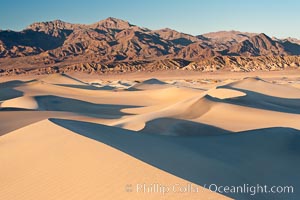
Sand Dunes and the Grapevine Mountains, California. Near Stovepipe Wells lies a region of sand dunes, some of them hundreds of feet tall.
Location: Stovepipe Wells, Death Valley National Park, California
Image ID: 15634
Location: Stovepipe Wells, Death Valley National Park, California
Image ID: 15634

Sand Dunes, California. Near Stovepipe Wells lies a region of sand dunes, some of them hundreds of feet tall.
Location: Stovepipe Wells, Death Valley National Park, California
Image ID: 15635
Location: Stovepipe Wells, Death Valley National Park, California
Image ID: 15635
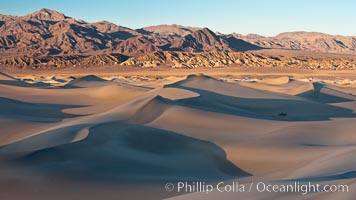
Sand Dunes and the Grapevine Mountains, California. Near Stovepipe Wells lies a region of sand dunes, some of them hundreds of feet tall.
Location: Stovepipe Wells, Death Valley National Park, California
Image ID: 15636
Location: Stovepipe Wells, Death Valley National Park, California
Image ID: 15636
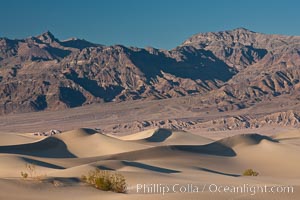
Sand Dunes and the Grapevine Mountains, California. Near Stovepipe Wells lies a region of sand dunes, some of them hundreds of feet tall.
Location: Stovepipe Wells, Death Valley National Park, California
Image ID: 15637
Location: Stovepipe Wells, Death Valley National Park, California
Image ID: 15637
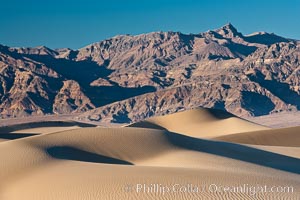
Sand Dunes and the Grapevine Mountains, California. Near Stovepipe Wells lies a region of sand dunes, some of them hundreds of feet tall.
Location: Stovepipe Wells, Death Valley National Park, California
Image ID: 15638
Location: Stovepipe Wells, Death Valley National Park, California
Image ID: 15638
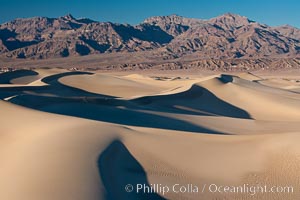
Sand Dunes and the Grapevine Mountains, California. Near Stovepipe Wells lies a region of sand dunes, some of them hundreds of feet tall.
Location: Stovepipe Wells, Death Valley National Park, California
Image ID: 15639
Location: Stovepipe Wells, Death Valley National Park, California
Image ID: 15639
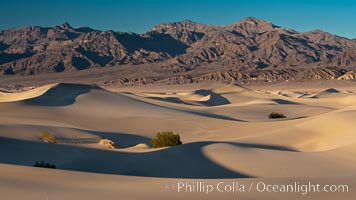
Sand Dunes and the Grapevine Mountains, California. Near Stovepipe Wells lies a region of sand dunes, some of them hundreds of feet tall.
Location: Stovepipe Wells, Death Valley National Park, California
Image ID: 15640
Location: Stovepipe Wells, Death Valley National Park, California
Image ID: 15640